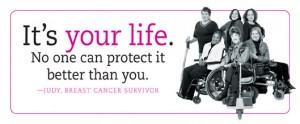 The CDC reports that women with disabilities between the ages of 50-74 report nearly 5% less mammography use than women without a disability of the same age.
The CDC reports that women with disabilities between the ages of 50-74 report nearly 5% less mammography use than women without a disability of the same age.
Women with a disability are more likely to die from breast cancer — even when diagnosed at the same stage as women without a disability. Regular screening (via mammogram) is the key to early detection of breast cancer, which can lower your risk of dying from the disease.
During Breast Cancer Awareness Month, the CDC’s Division of Human Development and Disability is focusing on the importance of breast cancer screening for women with disabilities.
Read the new CDC feature story for information and tips for women with disabilities. See also the “Right to Know” Overview for information on what the new campaign is for and why it’s necessary.
Screening recommendation:
If you are between 40-49 years old, talk to your doctor about when and how often to get a mammogram. If you are 50-74 years old, get a mammogram every two years.
What are the symptoms of breast cancer?
When breast cancer starts out, it is too small to feel and does not cause signs and symptoms. As it grows, however, breast cancer can cause changes in how the breast looks or feels. Symptoms may include:
- New lump in the breast or underarm (armpit).
- Thickening or swelling of part of the breast.
- Irritation or dimpling of breast skin.
- Redness or flaky skin in the nipple area or the breast.
- Pulling in of the nipple or pain in the nipple area.
- Nipple discharge other than breast milk, including blood.
- Any change in the size or the shape of the breast.
- Pain in any area of the breast.
What is a mammogram?
A mammogram is an X-ray of the breast. Doctors use a mammogram to look for early signs of breast cancer. Having regular mammograms can lower the risk of dying from breast cancer. If you are age 50 to 74 years, be sure to have a screening mammogram every two years. If you are age 40–49 years, talk to your doctor about when and how often you should have a screening mammogram.
Why should I have a mammogram?
Regular mammograms are the best tests doctors have to find breast cancer early, sometimes up to three years before it can be felt. When their breast cancer is found early, many women go on to live long and healthy lives.
How can I lower my risk of breast cancer?
- Control your weight and exercise.
- Limit the amount of alcohol you drink.
- Know your family history of breast cancer. If you have a mother, sister, or daughter with breast cancer, ask your doctor what your risk is of getting breast cancer and how you can lower your risk.
- Find out the risks and benefits of hormone replacement therapy.
Information About Breast Cancer:
Basic information (Centers for Disease Control)
Learn about cancer (American Cancer Society)
Cancer & Screening Tip Sheets:
English (PDF), Spanish / Español (PDF)
Cancer Survivors’ & Other Stories:
Diane: Audio (MP3), Transcript (PDF), Flyer (PDF)
Judi: Audio (MP3), Transcript (PDF), Flyer (PDF)
June: Audio (MP3), Transcript (PDF), Flyer (PDF)
Helen: Audio (MP3), Transcript (PDF), Flyer (PDF)
Get Your Mammogram (podcast)
Resources:
National Breast and Cervical Cancer Early Detection Program (NBCCEDP) provides low-income, uninsured, and underserved women access to timely breast and cervical cancer screening and diagnostic services.
Help Spread the Word:
Dissemination guide (PDF)
Free publicity materials
Facebook: ‘Like’ and ‘Share’ the CDC’s Awareness Post with your friends.
Twitter: ‘Retweet’ the CDC’s Awareness Tweet to your followers.
Share this post or any of the links and resources above via your social updates Myspace, Facebook, Google+ or Twitter.